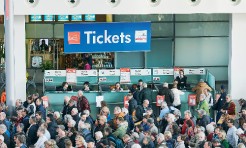What to do when things go wrong at virtual or in-person events?
In the event world, it’s simply part of life if things don’t work out as planned: At physical events, you can often fix things with a few simple hacks and a bit of improvisation: If a microphone fails you can simply replace it by a back-up without further ado. But in the digital world, the damage can be much greater. At a virtual event, similar difficulties could mean having to ditch the presentation completely. But be it online or offline, a professional response will keep your audience happy.

Expert:
Bettina Strohm-Knauer
Senior Content Marketing & PR Manager
Xing Events
Stay calm
We know, it’s easy to say but it's still a very valuable tip. “If getting upset helped solve problems, I'd get upset,” is a famous quote attributed to German Chancellor Angela Merkel. But once you are in a state of panic you can no longer think clearly and find new solutions. You just start behaving instinctively and emotionally. You cannot solve problems when you are paralysed with shock “like a rabbit in the headlights,” nor by a fight or flight response - but only by calm, analytical thinking.
Try to get to the root of the matter
The question is: What actually went wrong? This is not about laying blame, but about taking the first step towards finding a solution. For example, if you haven’t ordered enough bandwidth for a virtual event, you may still be able to fix things. For example, you can redirect to a public livestreaming platform, opening a second channel in this manner or you can simply refer to the recordings.
Explain and apologise
For the vast majority of event mishaps, there is a Plan B. But what if it doesn’t work? Then there’s only one thing left to do: explain with a lot of empathy what happened and apologise. Sometimes a bit of humour helps - it's worth taking example of some of the delay announcements on planes, trains or buses.

if it comes to the worst. (Photo: getty images / Xing Events)
Communicate before, on site and afterwards
Communicate before a malfunction? Yes, things that could go wrong should be communicated in advance. If it is your very first digital event, for example, you should definitely point this out. It's a good idea to explain up front what Plan B looks like for different scenarios. For example, an organiser could point to the recordings or public streaming via YouTube - as happened at the re:publica 2020 digital conference when the website servers were overloaded. It is always a good idea to have contacts for attendees who are seeking help - be it at the information desk on site or on the event platform. Likewise, a few well-prepared emergency documents and phrases will help. A set of slides with “We're experiencing technical glitches and will be right back” would be a good stop-gap solution for problems at virtual events. It’s also essential to brief moderators on how to react in the event of a breakdown. But the most important thing is to keep communicating. A five minute break in communication can be an eternity for people who are waiting. So you should communicate what is happening at regular intervals - even if there is nothing new to report. Communication is also necessary afterwards: explaining again how the crash occurred, apologising - and pointing out what will be done to prevent it from happening again. Of course, you should not make a mountain out of a molehill. But keeping shtum and hoping that nobody will remember won’t help either. Even in this case, depending on your target audience, a touch of humour might be appropriate.
Manage the community
The important thing is to keep an eye on your own community and respond before you come under fire. For virtual events, it would be a good idea to schedule a host for the session chat. He or she can instantly respond to comments such as “poor sound quality” - so that everyone can see - announcing that this will be handled promptly by a technician. The other online guests will no longer need to comment on the sound and can concentrate on the content of the online session again. If critical comments are posted on publicly visible platforms such as Facebook, YouTube, the Xing group or on other portals, you should respond and make an effort to communicate directly with the person in question as quickly as possible. It’s a good idea to offer a direct chat, a telephone call or communication by e-mail. This will move attackers out of the public space and into one-to-one communication, Making complaint discussions less harmful and the critic can respond to arguments and offers without losing face. In one-to-one communication, people often state their viewpoints and criticism more clearly and empathically.
This article was published in TFI issue 4/2021
Share in Facebook, Twitter or Google+:
TFI - Trade Fairs International - The International Trade Fair Magazine.
© 2006 - 2024 by TFI-Verlagsgesellschaft mbH. All rights reserved. TFI-Verlagsgesellschaft mbH shall accept no responsibility for the contents of external links and other contents.
TFI-Know-how
-
How can networking be made to work at online events?

Networking typically happens at real, in-person events. But it’s also possible to do it online; it just works a little differently. There are various options available to organisers.
-
How can exhibitors stand out at trade fairs?

New products and a well-conceived stand design are not the only drivers for a successful presence. Many other factors are also important, but trade fair planners often lose sight of them.
-
How can industry decision-makers be reached online?

Trade fairs and trade fair companies need to constantly further develop, become more agile and flexible and offer services all year round. New, digital offerings are very important here. With its TrustedTargeting technology, Messe München offers its customers access to leading business-to-business decision-makers on the Internet.
-
How can you maximise attention with your stand floor?

Most exhibitors want to attract as much traffic as possible. The largest continuous space of an exhibition stand can be actively used for this purpose: A photorealistic floor is a design option that fulfils several functions at once.


